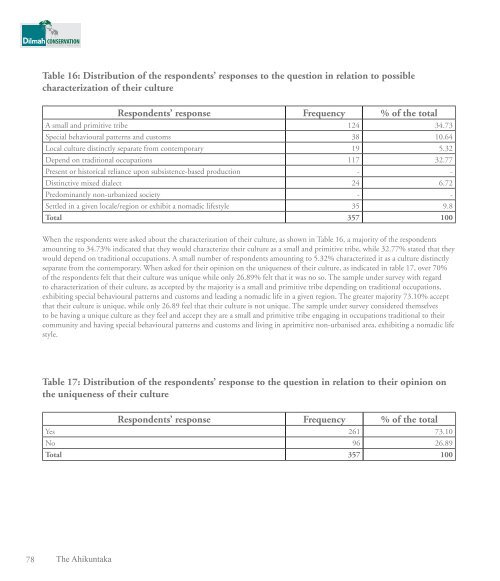The Ahikuntaka
A publication documenting the lives and livelihoods of the Ahikuntaka or gypsy community in Sri Lanka. A collection of vibrant photographs and a baseline survey on the current socio economic status of the Ahikuntaka conducted by the Colombo University complement this timely publication.
A publication documenting the lives and livelihoods of the Ahikuntaka or gypsy community in Sri Lanka. A collection of vibrant photographs and a baseline survey on the current socio economic status of the Ahikuntaka conducted by the Colombo University complement this timely publication.
Create successful ePaper yourself
Turn your PDF publications into a flip-book with our unique Google optimized e-Paper software.
www.dilmahconservation.org<br />
Table 16: Distribution of the respondents’ responses to the question in relation to possible<br />
characterization of their culture<br />
Respondents’ response Frequency % of the total<br />
A small and primitive tribe 124 34.73<br />
Special behavioural patterns and customs 38 10.64<br />
Local culture distinctly separate from contemporary 19 5.32<br />
Depend on traditional occupations 117 32.77<br />
Present or historical reliance upon subsistence-based production - -<br />
Distinctive mixed dialect 24 6.72<br />
Predominantly non-urbanized society - -<br />
Settled in a given locale/region or exhibit a nomadic lifestyle 35 9.8<br />
Total 357 100<br />
When the respondents were asked about the characterization of their culture, as shown in Table 16, a majority of the respondents<br />
amounting to 34.73% indicated that they would characterize their culture as a small and primitive tribe, while 32.77% stated that they<br />
would depend on traditional occupations. A small number of respondents amounting to 5.32% characterized it as a culture distinctly<br />
separate from the contemporary. When asked for their opinion on the uniqueness of their culture, as indicated in table 17, over 70%<br />
of the respondents felt that their culture was unique while only 26.89% felt that it was no so. <strong>The</strong> sample under survey with regard<br />
to characterization of their culture, as accepted by the majority is a small and primitive tribe depending on traditional occupations,<br />
exhibiting special behavioural patterns and customs and leading a nomadic life in a given region. <strong>The</strong> greater majority 73.10% accept<br />
that their culture is unique, while only 26.89 feel that their culture is not unique. <strong>The</strong> sample under survey considered themselves<br />
to be having a unique culture as they feel and accept they are a small and primitive tribe engaging in occupations traditional to their<br />
community and having special behavioural patterns and customs and living in aprimitive non-urbanised area, exhibiting a nomadic life<br />
style.<br />
Table 17: Distribution of the respondents’ response to the question in relation to their opinion on<br />
the uniqueness of their culture<br />
Respondents’ response Frequency % of the total<br />
Yes 261 73.10<br />
No 96 26.89<br />
Total 357 100<br />
78 <strong>The</strong> <strong>Ahikuntaka</strong>















